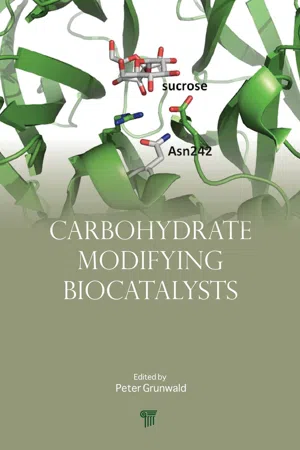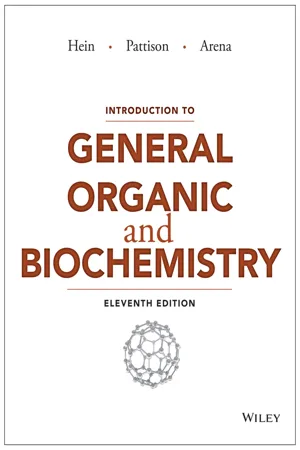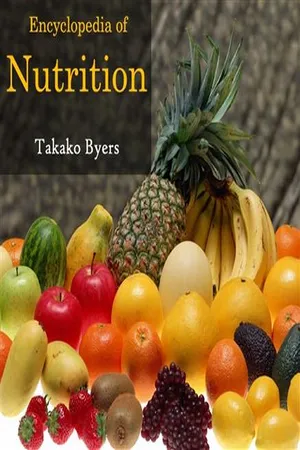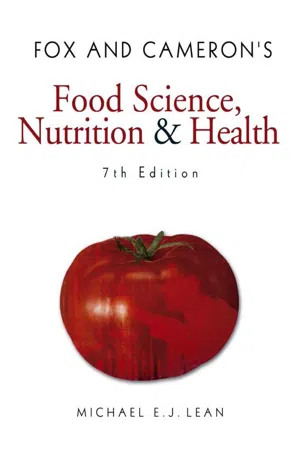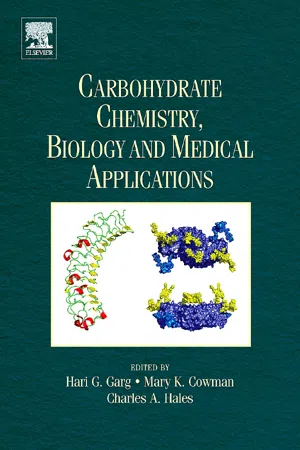Chemistry
Carbohydrates in nature
Carbohydrates are organic compounds found in nature, serving as a primary source of energy for living organisms. They are composed of carbon, hydrogen, and oxygen atoms, typically in a 1:2:1 ratio. In nature, carbohydrates are abundant in foods such as fruits, vegetables, grains, and legumes, and play essential roles in biological processes such as energy storage and structural support.
Written by Perlego with AI-assistance
Related key terms
1 of 5
10 Key excerpts on "Carbohydrates in nature"
- eBook - PDF
- Peter Grunwald(Author)
- 2011(Publication Date)
- Jenny Stanford Publishing(Publisher)
Chapter 1 BASICS IN CARBOHYDRATE CHEMISTRY Heinrich Hühnerfuss Department of Organic Chemistry, University of Hamburg, D-20146 Hamburg, Germany [email protected] 1.1 INTRODUCTION The terms carbohydrate , saccharide , and sugar are being used as synonyms: carbohydrate refers to the classical assumption that this class of compounds exclusively consists of the elements C, H, and O, where the latter two elements exhibit the same relation as encountered in water, i.e., a relation of 2:1. Accordingly, a general formula of C n (H 2 O) n was derived which was actually in line with the formulae of several basic sugars such as glucose (C 6 H 12 O 6 ) or ribose (C 5 H 10 O 5 ). However, though more detailed structural studies revealed that these compounds did not contain intact water molecules, the term carbohydrates persists. Furthermore, it was shown that many natural carbohydrates contain additional elements, e.g., nitrogen or sulphur. Saccharide stems from the word sugar in several early languages ( sarkara in Sanskrit, sakcharon in Greek, and saccharum in Latin). Carbohydrates are the most abundant class of bioorganic compounds in the biological world, making up more than 50% of the dry weight of the Earth’s biomass (Bruice, 2004). They play a Carbohydrate-Modifying Biocatalysts Edited by Peter Grunwald Copyright © 2012 Pan Stanford Publishing Pte. Ltd. www.panstanford.com 2 Basics in Carbohydrate Chemistry crucial role in various functions in living organisms. For example, several carbohydrates serve as a major source of metabolic energy. Grass, leaves, fruits, seeds, stems, and roots of plants contain carbohydrates that plants use for their own metabolic needs and that also serve the metabolic needs of animals that eat the plants. Other carbohydrates can be found as structural components in cells or they act as recognition sites on cell surfaces. - Morris Hein, Scott Pattison, Susan Arena, Leo R. Best(Authors)
- 2014(Publication Date)
- Wiley(Publisher)
Carbohydrates are among the most widespread and important biochemicals. Most of the matter in plants, except water, consists of these substances. Carbohydrates are one of the three principal classes of energy-yielding nutrients; the other two are fats and proteins. Because of their widespread distribution and their role in many vital metabolic processes such as photosynthesis, carbohydrates have been scrutinized by scientists for over 175 years. The name carbohydrates was given to this class of compounds many years ago by French scientists, who called them hydrates de carbone because their empirical formulas approximated (C # H 2 O) n . It was found later that not all substances classified as carbohy- drates conform to this formula (e.g., rhamnose, C 6 H 12 O 5 , and deoxyribose, C 5 H 10 O 4 ). It seems clear that carbohydrates are not simply hydrated carbon; they are complex substances that contain from three to many thousands of carbon atoms. Carbohydrates are generally defined as polyhydroxy aldehydes or polyhydroxy ketones or substances that yield these compounds when hydrolyzed. The simplest carbohydrates are glyceraldehyde and dihydroxyacetone: H H OH H H OH C C dihydroxyacetone, C 3 H 6 O 3 O C H O H H OH C C glyceraldehyde, C 3 H 6 O 3 OH C H carbonyl carbon These substances are “polyhydroxy” because each molecule has more than one hydroxyl group. Glyceraldehyde contains a carbonyl carbon in a terminal position and is therefore an aldehyde. The internal carbonyl of dihydroxyacetone identifies it as a ketone. Much of the chemistry and biochemistry of carbohydrates can be understood from a basic knowl- edge of the chemistry of the hydroxyl and carbonyl functional groups. (See Chapters 22 and 23 for review.) KEY TERM carbohydrate LEARNING OBJECTIVE When sugar (sucrose) and sulfuric acid (left) are combined, water is removed from the sugar, leaving a black column of carbon (right).- eBook - PDF
- Jose Perez-Castineira(Author)
- 2020(Publication Date)
- De Gruyter(Publisher)
3 Carbohydrates 3.1 Definition, terminology, and classification Carbohydrates are a family of biomolecules composed, in principle, by carbon (C), hydrogen (H), and oxygen (O) atoms whose basic general formula is C n (H 2 O) m . The fact that many carbohydrates have two atoms of hydrogen per atom of oxygen in their molecules is responsible for the somewhat misleading name that these mole- cules have, as “hydrate” means “containing water.” Carbohydrates have no water in their chemical composition, as we shall see in this Chapter, although they are usually hydrated to different degrees both in vivo and in vitro. Carbohydrates are usually constituted by an indeterminate number of basic units linked forming polymers. The connections among these units may occur by means of different linkage types, thereby allowing many structural variations [1]. There are several important terms related to carbohydrates: – Monosaccharides: They are the basic non-hydrolyzable units of carbohydrates. Monosaccharides can be chemically altered yielding derivatives that may also form polymers. These alterations may involve the addition of elements such as nitrogen (N), sulfur (S), or phosphorus (P). – Oligosaccharides. Molecules composed of 2 to 12 (20 for some authors) linked units (residues) of monosaccharides by a specific type of chemical bond known as glycosidic bond. Oligosaccharides are denoted according to the number of monosaccharide residues they have: disaccharides (2 units), trisaccharides (3), tetrasaccharides (4), and so on. – Sugar: Many monosaccharides and disaccharides are sweet, hence their trivial name sugars, although table sugar is only composed of sucrose, a disaccha- ride. Carbohydrates are also known as glycids (from the Greek glykys, glykeros: sweet) or saccharides (from the latin saccharum: sugar). – Polysaccharides: Polymers composed of more than 12 (or 20) residues of mono- saccharides. - eBook - PDF
- David Ucko(Author)
- 2012(Publication Date)
- Academic Press(Publisher)
ar drates Carbohydrates are one of your major sources of energy. They are synthesized by plants in a process called photosynthesis. Plants use the energy of sunlight to convert carbon dioxide, a waste product of your body, along with water into carbohydrate molecules. Carbohydrates serve as an important f u e l in humans because energy from the sun is stored in their chemical bonds. It is released w h e n carbohydrates are b u r n e d in your body. T o follow this process (which is described in detail in Chapter 17), you must understand the structures and properties of the most important carbohydrate molecules. ass at n ar drates Carbohydrates are organic molecules that contain carbon, hydrogen, and oxy-gen. At one time, it was thought that they were hydrates of carbon—there-fore, the name carbohydrate. Although many carbohydrate molecules do have the ratio o f two hydrogen atoms to one oxygen atom (as in H 2 0 ) for every carbon atom, this definition is not correct. Carbohydrates are related to either aldehydes or ketones and also contain hydroxyl groups. Thus, they can b e d e -fined as polyhydroxyl aldehydes or polyhydroxyl ketones ( p o l y means many) or as substances that produce these compounds upon hydrolysis (when they react with water) and their derivatives. Carbohydrates are classified according to their size. T h e largest carbohy-drates are polymers called polysaccharides; they contain many monomers linked together. These basic units, the simplest carbohydrates, are called monosaccharides. Polysaccharides can b e hydrolyzed, broken d o w n in a reac-tion with water (in the presence of acid) to produce monosaccharides. T h e monosaccharides, however, cannot b e changed to simpler molecules. In between the large polysaccharides and the single monosaccharides are the oligosaccharides. T h e y contain a small number of monosaccharide units, gen-erally from two to ten, b o n d e d together. T h e most important oligosaccharides 296 - No longer available |Learn more
- (Author)
- 2014(Publication Date)
- Learning Press(Publisher)
Carbohydrates perform numerous roles in living things. Polysaccharides serve for the storage of energy (e.g., starch and glycogen) and as structural components (e.g., cellulose in plants and chitin in arthropods). The 5-carbon monosaccharide ribose is an important component of coenzymes (e.g., ATP, FAD, and NAD) and the backbone of the genetic molecule known as RNA. The related deoxyribose is a component of DNA. Saccharides and their derivatives include many other important biomolecules that play key roles in the immune system, fertilization, preventing pathogenesis, blood clotting, and development. In food science and in many informal contexts, the term carbohydrate often means any food that is particularly rich in the complex carbohydrate starch (such as cereals, bread and pasta) or simple carbohydrates, such as sugar (found in candy, jams and desserts). Structure Formerly the name carbohydrate was used in chemistry for any compound with the formula C m (H 2 O) n . Following this definition, some chemists considered formaldehyde CH 2 O to be the simplest carbohydrate, while others claimed that title for glycolaldehyde. Today the term is generally understood in the biochemistry sense, which excludes compounds with only one or two carbons. Natural saccharides are generally built of simple carbohydrates called monosaccharides with general formula (CH 2 O) n where n is three or more. A typical monosaccharide has the structure H-(CHOH) x (C=O)-(CHOH) y -H, that is, an aldehyde or ketone with many hydroxyl groups added, usually one on each carbon atom that is not part of the aldehyde or ketone functional group. Examples of monosaccharides are glucose, fructose, and glyceraldehyde. - eBook - PDF
- Allan Blackman, Steven E. Bottle, Siegbert Schmid, Mauro Mocerino, Uta Wille(Authors)
- 2022(Publication Date)
- Wiley(Publisher)
CHAPTER 22 Carbohydrates 1151 FIGURE 22.3 To date, biofuels in Australia have mostly been produced from the waste of crops such as food crops, but efforts are underway to identify specific-purpose crops, such as switchgrass, that can be more efficiently converted to fuel. 22.1 Introduction to carbohydrates LEARNING OBJECTIVE 22.1 Define carbohydrates. Carbohydrates possess many functional groups, which leads to some interesting properties. They are also of fundamental importance as biochemicals. In earlier chapters we dealt with the individual functional groups found in carbohydrates (alcohols, aldehydes and ketones), so many of the properties, reactivities and concepts will be familiar. The range and variety of carbohydrate chemistry are immense and we will cover only the simplest forms. However, it is crucial to remember that all carbohydrates, no matter how complex, are governed by the properties of the individual chemical groups from which they are constructed. The word ‘carbohydrate’ means ‘hydrate of carbon’ and derives from the formula C n (H 2 O) m . Two examples of carbohydrates with molecular formulae that can be written as hydrates of carbon are: • glucose (blood sugar), C 6 H 12 O 6 , which can be written as C 6 (H 2 O) 6 • sucrose (table sugar), C 12 H 22 O 11 , which can be written as C 12 (H 2 O) 11 . However, not all carbohydrates have this general formula. Some contain too few oxygen atoms, and some contain too many. Some also contain nitrogen. But the term ‘carbohydrate’ has become firmly rooted in chemical nomenclature and, although not completely accurate, it persists as the name for this class of compounds. At the molecular level, most carbohydrates are polyhydroxyaldehydes, polyhydroxyketones or com- pounds that yield them after hydrolysis. - Michael EJ Lean(Author)
- 2006(Publication Date)
- CRC Press(Publisher)
Carbohydrates Carbohydrates constitute one of the three main classes of ‘macro-nutrients’. They occur in food as sugars and starches, which are a major source of energy in the diet, and as cellulose which is the main non-starch polysaccharide. Sugars are produced in plants as the end product of photosynthesis, from carbon dioxide and water. At the same time oxygen is evolved, as shown in the equation for the formation of the simple carbohy-drate glucose: Water appears on both sides of this equation because it has been shown that all the oxygen evolved ori-ginates from the water. The oxygen atoms in the glucose and water molecules on the right-hand side of the equation are those which were originally com-bined with carbon in the carbon dioxide. The equa-tion is a comparatively simple one, but it shows only the starting materials and final products of a series of complex reactions. The building-up of carbohydrate molecules by plants is accomplished by photosynthesis. Energy is required to transform the carbon dioxide and water into carbohydrates and this is supplied by the action of sunlight on chlorophyll in the leaves.Consequently, photosynthesis does not take place in the dark. Animals, including man, are unable to synthesize carbohydrates, and this is one of the fundamental differences between animals and plants. The sugars formed by photosynthesis are transported within the plant as sucrose, which is soluble in water. Sucrose is subsequently converted by the plant to polysacchar-ides, the most important of which are starch and cel-lulose. Starch is the principal energy reserve of most plants stored in tubers and elsewhere, whereas cellu-lose, which is the main component of plant walls, provides structural support and synthesized in growing plants of plants.- eBook - PDF
- Paul Kramer(Author)
- 2012(Publication Date)
- Academic Press(Publisher)
Carbohydrates Introduction 258 Kinds of Carbohydrates 259 Monosaccharides 259 Oligosaccharides 260 Polysaccharides 261 Carbohydrate Transformations 263 Phosphorylation 264 Sucrose 265 Starch 265 Uses of Carbohydrates 266 Growth 267 Accumulation of Carbohydrates 268 Carbohydrate Distribution 268 Uses of Reserve Carbohydrates 271 Seasonal Cycles in Carbohydrate Content 274 Autumn Coloration 277 General References 281 INTRODUCTION Carbohydrates are of special importance because they are direct products of photo-synthesis and are, therefore, the primary energy storage compounds and the basic organic substances from which most other organic compounds found in plants are synthesized. Carbohydrates also are the chief constituents of cell walls; they are the starting point for the synthesis of fats and proteins; large amounts are oxidized in respiration (see Chapter 6); another fraction is accumulated as reserve foods; and still another fraction is variously lost from plants. Soluble carbohydrates increase the osmot-ic pressure of the cell sap, and such carbohydrates as the pentosans, pectic com-pounds, gums, and mucilages increase the water-holding capacity of tissues. Quantita-tively, carbohydrates are the most important constituents of woody plants, comprising about three-fourths of their dry weight. This chapter deals with the kinds of carbohy-drates found in woody plants, their uses, accumulation, and losses. 258 - eBook - PDF
- H. Stephen Stoker(Author)
- 2015(Publication Date)
- Cengage Learning EMEA(Publisher)
Chlorophyll 88888888n Plant enzymes carbohydrates 1 O 2 CO 2 1 H 2 O 1 solar energy Plants have two main uses for the carbohydrates they produce. In the form of cellulose, carbohydrates serve as structural elements, and in the form of starch, they provide energy reserves for the plants. Dietary intake of plant materials is the major carbohydrate source for humans and animals. The average human diet should ideally be about two-thirds carbohydrate by mass. ◀ Carbohydrates have the following functions in humans: 1. Carbohydrate oxidation provides energy. 2. Carbohydrate storage, in the form of glycogen, provides a short-term energy reserve. 3. Carbohydrates supply carbon atoms for the synthesis of other biochemical substances (proteins, lipids, and nucleic acids). 4. Carbohydrates form part of the structural framework of DNA and RNA molecules. 5. Carbohydrates linked to lipids (Chapter 8) are structural components of cell membranes. 6. Carbohydrates linked to proteins (Chapter 9) function in a variety of cell–cell and cell–molecule recognition processes. Figure 7-2 Most of the matter in plants, except water, is carbohydrate material. Photosynthesis, the process by which carbohydrates are made, requires sunlight. © PictureNew/Corbis ▶ It is estimated that more than half of all organic carbon atoms are found in the carbohydrate materials of plants. ▶ Human uses for carbohydrates of the plant kingdom extend beyond food. Carbohydrates in the form of cotton and linen are used as clothing. Carbohydrates in the form of wood are used for shelter and heating and in making paper. 1. Which of the following statements concerning the abundance of carbohydrates is incorrect ? a. They are the most abundant type of bioorganic molecule on planet Earth. b. They are the most abundant type of bioorganic molecule in the plant world. c. They are the most abundant type of bioorganic molecule in the human body. - Hari G. Garg, Mary K. Cowman, Charles A. Hales(Authors)
- 2011(Publication Date)
- Elsevier Science(Publisher)
The Dictionary of Carbohydrates (155) has a listing of some 24,000 individual carbohydrates, giving names, structures, sources, data, and literature references for each, together with a complementary electronic database. Another valuable refer-ence work that includes a wealth of information on carbohydrate derivatives important in biochemistry and biology is the Oxford Dictionary of Biochemistry and Molecular Biology (156). Among the smaller single-author texts on carbohydrates may be noted the Ferrier–Collins book Monosaccharide Chemistry (157) and Stick’s Carbohydrates: The Sweet Molecules of Life (158), which includes a brief treatment of biological aspects. Lehmann’s book Carbohydrates: Structure and Biology (127) has the biological and biochemical aspects of carbohydrates as its central focus, and is particularly useful for gaining a broad overview of the subject. References 1. Marcus Porcius Cato (Cato the Elder). De Agricultura. ca 184 BCE, http://soi-landhealth.org/01aglibrary/010121cato/catofarmtext.htm, chapter 87. 2. Robyt JF. Essentials of Carbohydrate Chemistry. Springer, New York, 1997; 42–44. 3. Bassham J, Benson A, Calvin M. The path of carbon in photosynthesis. J Biol Chem 1950; 185:781–787. 4. Bassham JA. Mapping the carbon reduction cycle: a personal retrospective. Photosynthesis Res 2003; 76:25–52. 5. Kirchoff GSC. Acad Imperale St Petersbourg, Mem 1811; 4:27. The Development of Carbohydrate Chemistry and Biology 21 6. Willsta ¨ tter R, Zechmeister L. Hydrolysis of cellulose I. Ber 1913; 46:2401–2412. 7. Monier-Williams GW. Hydrolysis of cotton cellulose. J Chem Soc 1921; 119:803–805. 8. Fischer E. Untersuchungen u ¨ ber Kohlenhydrate und Fermente, 1884–1908. Berlin: Julius Springer, 1909. 9. Fischer E. Synthesen in der Zuckergruppe I. Ber 1890; 23:2114–2143. 10. Lichtenthaler FW. Emil Fischer, his personality, his achievements, and his scientific progeny. Eur J Org Chem 2002; 4095–4122. 11. Trommel J, Bijvoet JM.
Index pages curate the most relevant extracts from our library of academic textbooks. They’ve been created using an in-house natural language model (NLM), each adding context and meaning to key research topics.
